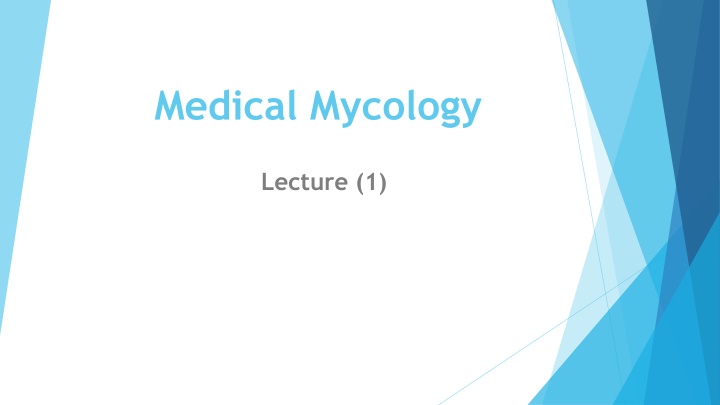
Medical Mycology Fundamentals
Explore the intriguing world of medical mycology, which delves into the study of fungi, their genetic properties, taxonomy, and their diverse roles in human life. From medicinal uses like penicillin to dangers posed by fungal infections, this lecture sheds light on the importance of fungi in various aspects of our daily lives.
Download Presentation

Please find below an Image/Link to download the presentation.
The content on the website is provided AS IS for your information and personal use only. It may not be sold, licensed, or shared on other websites without obtaining consent from the author. If you encounter any issues during the download, it is possible that the publisher has removed the file from their server.
You are allowed to download the files provided on this website for personal or commercial use, subject to the condition that they are used lawfully. All files are the property of their respective owners.
The content on the website is provided AS IS for your information and personal use only. It may not be sold, licensed, or shared on other websites without obtaining consent from the author.
E N D
Presentation Transcript
Medical Mycology Lecture (1)
Introduction to medical mycology MYCOLOGY is the study of fungi Myco- = fungi - mykes (mushroom) -logy = the study of
Mycology The study of fungi, includes their genetic and biochemical properties, their taxonomy, and their use to humans as source for: -medicinal (e.g., penicillin), - food (e.g., beer, wine, cheese, mushrooms ), -as well as their dangers, such as poisoning or infection.
Definition of fungi Planta Animalia Fungi Protista Monera. Living world is divided into the five kingdoms eukaryotic Heterotrophic unicellular to filamentous rigid cell wall spore bearing organisms Fungi sexual a sexual
Definition of fungi a- Eukaryotic cells contain membrane bound cell organelles including nuclei, mitochondria, Golgi apparatus, endoplasmic reticulum, lysosomes etc. b- Heterotrophic - fungi lack chlorophyll and are therefore not autotrophic (photosynthetic) like plants and algae; rather they are heterotrophic absorptive organisms that are either saprophytes (living on dead organic matter) or parasites (utilizing living tissue). c- Like plants, fungi have rigid cell walls and are therefore non-motile, a feature which separates them from animals.
Structure of Fungi. (a) A unicellular or yeast form blastoconidia pseudohyphae (b) A filamentous or mould form which is a vegetative growth of filaments . There are two kinds of hyphae: 1-non-septate( Zygomycetes) 2-septate(basidiomycetes and ascomycetes)
DIMORPHIC FUNGI 1- Growth as a mold : in soil or media (SDA,PDA) incubated at 25 C 2- Growth as a yeast : in the tissues of an animal/human or media (Brain heart infusion agar BHI ) incubated at 37 C Ex: Candida albicans
Reproduction in Fungi (a) Sexual reproduction is produced by the fusion of two nuclei that then generally undergo meiosis. 1-plasmogamy (cytoplasmic fusion of two cells) 2- karyogamy (fusion of two nuclei) 3-genetic recombination and meiosis (resulting haploid spore ) e.g. zygospores, ascospores and basidiospores.
Reproduction in Fungi (b) Asexual reproduction (somatic or vegetative reproduction) occurs by variety of mechanisms. 1-Budding 2-Fission 3-Fragmentation of hyphae 4-Asexual spores
Classification of Fungi. Separation of taxa is still primarily based on the method of spore production three major phylum Zygomycota, Ascomycota and Basidiomycota There is a subphylum called the Deuteromycotina (imperfect fungi ) which may represent the asexual states (anamorphs) of either Basidiomycota or Ascomycota.
Antifungal agent 1-Polyene Antifungal Drugs : Amphotericin, nystatin, and pimaricin interact with sterols in the cell membrane to form channels through which small molecules leak from the inside of the fungal cell to the outside.
Antifungal agent 2-Azole Antifungal Drugs Fluconazole, itraconazole, and ketoconazole inhibit cytochrome P450-dependent enzymes involved in the biosynthesis of ergosterol, which is required for fungal cell membrane structure and function.
Antifungal agent 3-Allylamine and Morpholine Antifungal Drugs Allylamines (naftifine, terbinafine) inhibit ergosterol biosynthesis at the level of squalene epoxidase. 4-Antimetabolite Antifungal Drugs Fluorocytosine inhibitor of both DNA and RNA synthesis
Lab Diagnoses of Mycoses 1- Clinical presentation History (risk factors)- Physical Exam (lesions,ets) Mould or Yeast? -Septate hyphae? 2- Culture of organism (days to weeks) (SDA). (SDA )with antibiotics , (BHIA) 3- Serology-Antibody or Antigen tests 4- Molecular Biology-PCR






















